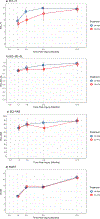Unreamed Intramedullary Nailing Versus External Fixation for the Treatment of Open Tibial Shaft Fractures in Uganda: A Randomized Clinical Trial
- PMID: 35234730
- PMCID: PMC9391253
- DOI: 10.1097/BOT.0000000000002362
Unreamed Intramedullary Nailing Versus External Fixation for the Treatment of Open Tibial Shaft Fractures in Uganda: A Randomized Clinical Trial
Abstract
Objective: To compare unreamed intramedullary nailing versus external fixation for the treatment of Gustilo-Anderson type II and IIIA open tibial fractures admitted to a hospital in rural Uganda.
Design: Randomized clinical trial.
Setting: Regional referral hospital in Uganda.
Patients: Fifty-five skeletally mature patients with a Gustilo-Anderson type II or IIIA open tibia shaft fracture treated within 24 hours of injury between May 2016 and December 2019.
Intervention: Unreamed intramedullary nailing (n = 31) versus external fixation (n = 24).
Main outcome measurements: The primary outcome was function within 12 months of injury, measured using the Function IndeX for Trauma (FIX-IT) score. Secondary outcomes included health-related quality of life (HRQoL) using the 3-level version of the 5-dimension EuroQol instrument (EQ-5D-3L), radiographic healing using the Radiographic Union Scale for Tibia (RUST) fractures score, and clinical complications.
Results: Treatment with an intramedullary nail resulted in a 1.0-point higher [95% credible intervals (CrI), 0.1 to 1.9] FIX-IT score compared with external fixation. Results were similar for the secondary patient-reported outcomes, EQ-5D-3L and the visual analog scale component of the EuroQol instrument (EQ-VAS). RUST scores were not different between groups at any time point. Treatment with an intramedullary nail was associated with a 22.1% (95% CrI, -42.6% to 1.7%) lower rate of malunion and a 20.8% (95% CrI, -44.0% to 2.9%) lower rate of superficial infection.
Conclusion: In rural Uganda, treatment of open tibial shaft fractures with an unreamed intramedullary nail results in marginal clinically important improvements in functional outcomes, although there is likely an important reduction in malunion and superficial infection.
Level of evidence: Therapeutic Level II. See Instructions for Authors for a complete description of levels of evidence.
Copyright © 2022 Wolters Kluwer Health, Inc. All rights reserved.
Conflict of interest statement
N. N. O'Hara reported receiving stock or stock options from Arbutus Medical, Inc. unrelated to this research. G. P. Slobogean reported receiving research funding from the Patient-Centered Outcomes Research Institute, the US Department of Defense, and the National Institutes of Health unrelated to this research; serving as a paid consultant with Smith & Nephew and Zimmer Biomet unrelated to this research; and receiving personal fees from Nuvasive Orthopaedics unrelated to this research. The remaining authors report no conflict of interest.
Figures



References
-
- Johal H, Schemitsch EH, Bhandari M. Why a decade of road traffic safety? J Orthop Trauma. 2014;28 Suppl 1:S8–10. - PubMed
-
- O’Hara NN, Mugarura R, Potter J, et al. Economic loss due to traumatic injury in Uganda: the patient’s perspective. Injury. 2016;47:1098–1103. - PubMed
-
- O’Hara NN, Mugarura R, Potter J, et al. The socioeconomic implications of isolated tibial and femoral fractures from road traffic injuries in Uganda. J Bone Joint Surg Am. 2018;100:e43. - PubMed
Publication types
MeSH terms
Grants and funding
LinkOut - more resources
Full Text Sources
Medical
Research Materials

